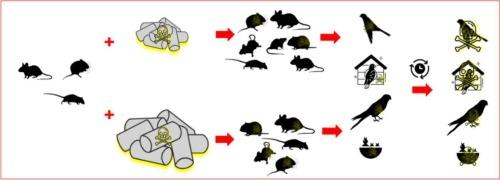第二代抗凝血灭鼠剂生态相关暴露对猛禽风险的预测框架
IF 8
1区 环境科学与生态学
Q1 ENVIRONMENTAL SCIENCES
引用次数: 0
摘要
在全球范围内,由于暴露于化学污染物等原因,许多猛禽物种的数量正在下降。第二代抗凝血灭鼠剂(SGAR)残留物通常在猛禽的肝脏中发现,表明饮食暴露和潜在的继发性中毒。我们对猛禽在不同生命阶段和不同使用制度下的SGAR暴露的理解存在差距。我们为非目标物种开发了一个新的建模框架,以普通红隼(Falco tinnunculus)为例,改进了常用的风险评估。我们的情景模拟了四种不同的灭鼠剂在猛禽不同生命阶段的高和低食用量、高和低食用量的啮齿动物食用量。根据监管机构使用的亚致死和致死效应阈值对猛禽的风险进行了评估。我们的模型表明,暴露于溴化氢超过了致死和亚致死效应的阈值。正在繁殖的成虫和雏鸟有因接触灭虫灵和溴代灭虫灵和灭虫灵的混合物而产生亚致死效应的风险。这是令人担忧的,因为由于啮齿类动物对其他SGARs的耐药性增加,溴灭菌和硫虫酮的全球使用量似乎正在上升。在以前没有风险的情况下,双硫虫酮代表累积风险,在一周内达到阈值,避免在猛禽繁殖季节使用SGAR将降低继发性SGAR中毒的可能性和影响。我们的框架可用于评估SGAR和猛禽在生态环境中的不同暴露情景,以指导SGAR的使用和监管。本文章由计算机程序翻译,如有差异,请以英文原文为准。

Predictive framework for estimating the risks to raptors from ecologically relevant exposure to second generation anticoagulant rodenticides
Globally, populations of many raptor species are declining for reasons including exposure to chemical contaminants. Second Generation Anticoagulant Rodenticide (SGAR) residues are commonly found in the livers of raptors, indicating dietary exposure and potentially secondary poisoning. There is a gap in our understanding of SGAR exposure for raptors at different life stages and under different usage regimes.
We develop a new modelling framework for non-target species to refine the commonly applied risk assessment using the common kestrel (Falco tinnunculus) as a case study. Our scenarios simulate high and low rodent consumption by raptors with high and low SGAR usage, of four different rodenticides at different raptor life stages. The risk to raptors was evaluated in reference to sublethal and lethal effect thresholds used by regulators.
Our model suggests exposure to Brodifacoum exceeds the threshold for lethal and sublethal effects. Breeding adults and nestlings are at risk of sublethal effects from Difethialone and the mixture of Bromadiolone and Difenacoum exposure. This is concerning because Brodifacoum and Difethialone usage seems to be rising globally due to increased resistance of rodents to other SGARs. Difethialone represents cumulative risk in scenarios previously not a risk, reaching the threshold in a week Avoiding SGAR usage during the raptor breeding season would reduce the likelihood and impact of secondary SGAR poisoning. Our framework can be used to assess different exposure scenarios for SGARs and raptors in ecological meaningful contexts to guide SGAR usage and regulation.
求助全文
通过发布文献求助,成功后即可免费获取论文全文。
去求助
来源期刊

Science of the Total Environment
环境科学-环境科学
CiteScore
17.60
自引率
10.20%
发文量
8726
审稿时长
2.4 months
期刊介绍:
The Science of the Total Environment is an international journal dedicated to scientific research on the environment and its interaction with humanity. It covers a wide range of disciplines and seeks to publish innovative, hypothesis-driven, and impactful research that explores the entire environment, including the atmosphere, lithosphere, hydrosphere, biosphere, and anthroposphere.
The journal's updated Aims & Scope emphasizes the importance of interdisciplinary environmental research with broad impact. Priority is given to studies that advance fundamental understanding and explore the interconnectedness of multiple environmental spheres. Field studies are preferred, while laboratory experiments must demonstrate significant methodological advancements or mechanistic insights with direct relevance to the environment.
 求助内容:
求助内容: 应助结果提醒方式:
应助结果提醒方式:


